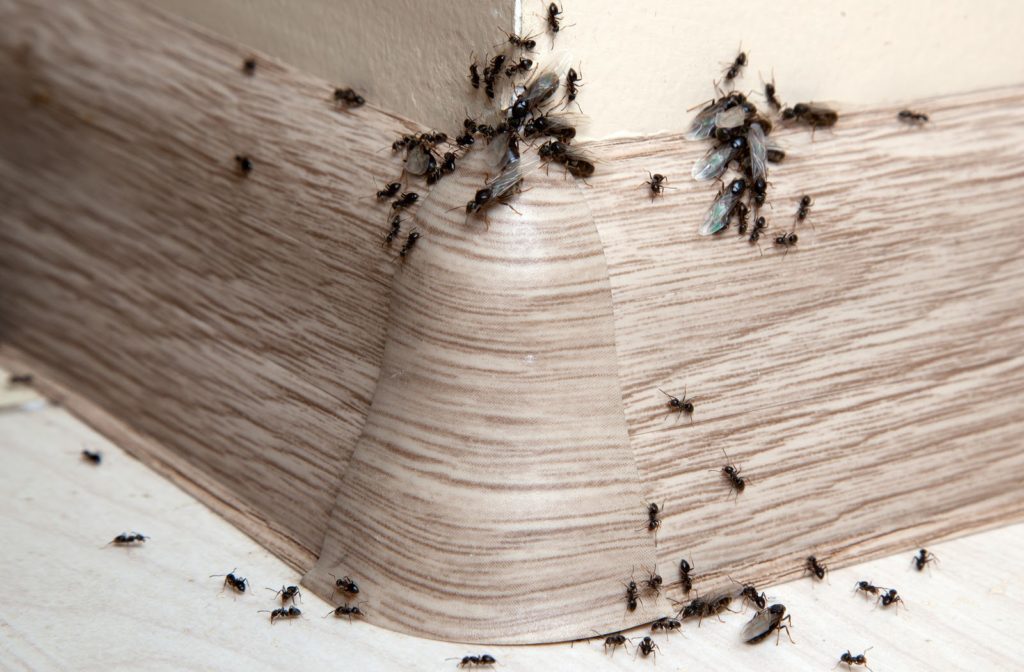Once summer rolls around, ants can become quite a nuisance. They are an important part of our ecosystem but can become unwanted, destructive pests once they infiltrate our living spaces. If you are currently dealing with an ant infestation, contact Dustin Pest Control to see what options you have for treatment.
Ants in California
Carpenter Ants
Carpenter ants are among the largest ants in North America. These ants can’t sting but can inflict painful bites with their powerful jaws and spray formic acid into the wound, causing a burning sensation.
Carpenter ants build their nests in decaying or damp wood. Their tunnels can eventually compromise the integrity of the wood in a house’s structure, which can lead to cosmetic and structural damage.
Argentine Ants
These ants do not harm humans but are an urban pest that destroys plant life. Argentine ants exist in large colonies and reproduce quickly. If they make their way into your home, they can rapidly start eating and compromising your food and vegetation.
Odorous House Ants
These ants do not pose a threat to humans but can contaminate and ruin food supplies. They are typically brown or black in color and are relatively small compared to other ants. They get their namesake from the foul odor they produce when crushed.
Southern Fire Ants
Southern fire ants are usually amber-colored with a black abdomen. These ants can directly harm humans through their painful stings. Outside they nest in small mounds or patches of loose soil near moisture, and also may be found in wood or under rocks and boards. When indoors, they nest in wall voids, crawl spaces, and under carpets.
Pavement Ants
Pavement ants usually reside underneath sidewalks, driveways, and the foundations of buildings. They do not pose a threat to humans directly but can contaminate food supplies.

How Do Ants Get into Your Home?
Ants enter your home through cracks and crevices where wires and piping are usually found. They are usually drawn into areas like the kitchen or bathroom due to access to water. Stretches of rain or flooding can also destroy ant nests and force them to look for shelter inside of buildings and houses.
Can Ants Damage Your Home?
Certain types of ants can pose a threat to the integrity of your home. It is important to identify what type of ant is infesting your home to learn if they can damage its structure.
In particular, the tunnels that carpenter ants make can compromise the integrity of the wood in a house’s structure, leading to cosmetic and structural damage.
Preventing Ant Infestations
Some ways to prevent ant infestations before they happen are:
- Keeping food in sealed containers
- Regularly recycling your bottles and cans
- Keeping surfaces clean and sterile
- Clean and monitor moist or damp areas of your home
- Seal cracks and crevices on the outside of your home
- Try to find ant colonies around your home, and quickly deal with the nests through the use of insecticides
It is tough to completely control the infestation of ants outside of your home, so if you know that there are currently colonies residing in your yard or garden, contact Dustin Pest Control to set up a preventative “shield”.
Treating Ant Infestations
Ant management requires the combined use of mechanical, cultural, sanitation, and often chemical control methods. It is impractical to attempt to totally eliminate ant colonies from an outdoor area. You should focus your efforts on excluding ants from buildings or valuable plants, and eliminating their food and water sources. Even slightly reducing outdoor sources of ants near buildings will reduce the likelihood of ants coming indoors. It is important to first monitor and inspect your home for ants so you can discern where the ants are entering your home and what area of your home they are residing in. It can also be helpful to recognize the trail or route they take to enter your home from their nest.
Baits
Ant baits contain insecticides mixed with materials that attract worker ants looking for food. Ants will become attracted to the bait and recruit other workers to it. Workers carry small portions of the bait back to the nest where it is transferred to other workers, larvae, and queens to kill the entire colony. Bait products are required to be slow-acting so that the foraging ants have time to get back to the nest and feed other members of the colony before they are killed. When used properly, baits are more effective and safer than sprays.
Baits are available for purchase in several different forms. If you are a residential user, the most readily available forms of ant bait are solids or liquids that are prepackaged into ant stakes or small plastic bait station containers. These products are easy to use and safe. Some products dry up rapidly and must be frequently replaced to manage a large population.
Ant baits contain carbohydrates, proteins, oils, or a combination of these as attractants along with an active ingredient (toxicant). Different types of attractants are more effective against different species of ants and at different times of the year. For example, for Argentine ants, sweet baits are attractive year-round, but protein baits are more attractive to them primarily in the spring. Fire ants prefer baits containing oils. Using a small quantity of each kind of bait and observing which one the ants prefer is a good way to determine which bait will be most effective.
To improve the effectiveness of ant bait, be sure to remove any particles of food, residues of sweet liquids, or other attractive material from cracks around sinks, pantries, and other ant-infested areas.


